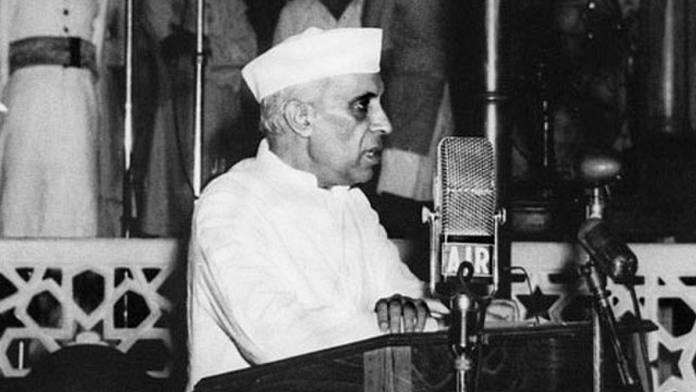New Delhi: At a time when Trump’s tariff war against India has put a question mark on the Modi government’s multi-alignment strategy, the launch of a book chronicling Nehru’s non-alignment foreign policy became a platform to highlight the practical politics of the former prime minister.
“Nehru shows how to do practical politics in a moral way, it is possible. And it was possible at a certain time,” said Shivshankar Menon, former Foreign Secretary of India, at the launch of The Nehru Years: An International History of Indian Non-Alignment by Swapna Kona Nayudu at the India International Centre.
The book explores how Nehru’s non-alignment policy shaped India’s approach to key international events such as the Korean War, the Suez Crisis, the Hungarian Revolution, and the Congo Crisis.
The discussion delved into Nehru’s unknown, unwritten stories and foreign commitments, with insights from Nayudu, and former Foreign Secretaries Shyam Saran and Shivshankar Menon. The event was moderated by Dr. Constantino Xavier, Senior Fellow, Foreign Policy and Security Studies, Centre for Social and Economic Progress (CSEP).
The seminar hall was filled to capacity with friends of the author, individuals interested in foreign policy, and those curious about Jawaharlal Nehru. During the one-hour session, the room remained packed, with some attendees even standing at the back. Many raised their hands eagerly, asking questions about the book, Nehru’s policies, his ideology, and the research process behind the work.
The book chronicles the early decades of the Cold War and how global diplomacy was largely defined by the United States and the Soviet Union. And amid this polarised landscape, Nehru envisioned a radically independent course for India—non-alignment. It was not only passive neutrality, but a stance of active mediation, moral clarity, and above all, a deeply humanistic vision of international order.
“Non-alignment was bold. It was a high-risk strategy. It gave India a certain freedom, but also came with the constant danger of overreach, overcommitment, or irrelevance,” said Menon.
Also read: ‘Fat-shamers are now Ozempic-shamers’ — new book takes on India’s weight-loss obsession
Nehru’s Non-Alignment
Nayudu also shared some difficulties she encountered during her research and studies on Nehru.
On the day she began her research at the National Archives of India, Nayudu recalled finding a file lying on the floor. It contained Jawaharlal Nehru’s personal notes from his 1958 visit to Bhutan, including records of his conversations with the Third King of Bhutan.
It changed the way she viewed Nehru, not as a distant political figure, but as someone deeply engaged and thoughtful about his role and responsibilities for the country.
She emphasised how important it is for future researchers and scholars to access and understand such documents.
Reflecting on this experience, Nayudu spoke about the gaps in historical records, not just in the Indian context, but globally—which can be filled by deep research and by writing what isn’t yet documented.
Responding to a question about whether her book could be considered revisionist history and what difficulties she faced during her research, Nayudu explained her position with a thoughtful example. While writing about the history of the Congo, she found no existing work to critically engage with. “There’s no piece of work I can point to and say, ‘I don’t agree with you.’ There’s nothing to agree or disagree with,” said Nayudu.
“These histories were never written in the first place. It’s not about revision, it’s about insertion. It’s about populating the record with their stories,” she added.
Saran stressed that Nehru’s non-alignment was not just for India, but for the entire world. He cited the example of Austria in the 1950s.
At the time, Austria was trying to regain its freedom and sovereignty after World War II. Some Austrian leaders believed they should negotiate directly with the Soviet Union, but their ultimate goal was neutrality to avoid siding with either the US or the USSR (Union of Soviet Socialist Republics).
“Non-alignment was crucial for world peace. It was probably the biggest peace movement after the Second World War,” said Saran.
Also read: Mughal paintings held clues that led archaeologist to a Christian chapel, Akbar’s Ibadat Khana
Relevance of Nehru’s vision
Speaking about the challenges faced by Nehru’s vision and foreign policy in contemporary times, Nayudu explained that Nehru and the study of Nehru mostly suffer from ‘presentism,’ the tendency to judge historical figures by today’s standards.
“Nehru studies suffer from presentism. When we talk about Nehru, when we evaluate him using today’s foreign policy frameworks, we forget that we’re talking about 1947—a state, a nation-state, that didn’t even fully exist yet when it became a founding member of the UN,” Nayudu said.
Despite this, Nehru and India made bold and ambitious decisions in shaping global affairs.
“Through the UN, Nehru initiated the creation of a new world order. This is the kind of role that major powers like China are attempting to play today—but Nehru was already doing this back in the 1950s,” Nayudu added.
As the floor opened for audience questions, the hall erupted. Questions included: Was Nehru committed to the liberal international order, and did that limit his vision? Was the 1962 Sino-Indian War a failure of non-alignment? How did non-aligned countries justify poor human rights records? And how relevant is Nehru’s vision today?
Addressing the final question, Nayudu said that Nehru’s ideas, especially non-alignment and multilateralism, remain relevant in today’s geopolitical landscape. She emphasised that his legacy should be understood in historical context rather than as a point of direct comparison.
“What we call ‘strategic autonomy’ today is exactly what Nehru practised,” she said
(Edited by Theres Sudeep)




